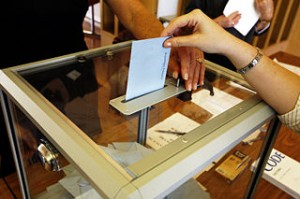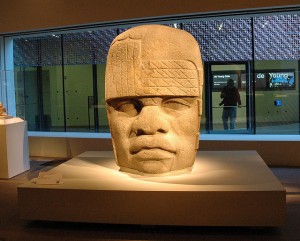
The image you see above is a flow chart describing the process by which the bodies of illegal aliens, or in the parlance of the presenter, “undocumented border crossers,” found in the United States are identified and returned to their families. Or, in the case of those whose identities can not be verified, disposed of. It was part of a presentation by Luis Torrens, a student pursuing a Master’s in Public Health, who was invited to address a day-long seminar hosted by the CUNY Graduate Center and the Immigration Working Group which I attended yesterday. I attended the final session of the event, which was billed as a discussion of “immigration Policy and Undocumented Immigrants” and focused exclusively upon the lives of illegal aliens living-and dying-within the United States.

Notwithstanding the ideologically blinkered nature of the discussion-of all the discussions, to be frank-I did glean some valuable insights from most of the presentations, which consisted of original research by professors and graduate students seeking grants for further exploration of the subject of their studies. In the case of Mr. Torrens, that entailed devising a better method for the identification and recovery of the bodies of illegal border crossers from Mexico into the United States. He has pursued this goal by interviewing medical examiners and coroners from 44 border counties located in Arizona, California, and New Mexico. One of the most interesting findings from his study was the discovery that although the number of illegal border crossers apprehended has decreased in recent years, a 35 % decline from 2008-2009, the number of border crossers who have died has increased significantly, rising from 125 in the last decade of the 20th century to 802 in the years from 2000-2005. According to the General Accounting Office, most of these deaths are a result of the extreme heat and severe climatic conditions found in the desert along the Mexican-American border.
Torrens suggested that this increase in heat-related deaths is a logical consequence of three border enforcement measures pursued during the Clinton administration, which he described as having a “funnel effect” intended to push illegal Mexican border crossers into the most inhospitable of environments. These three border enforcement tools were Operation Hold the Line, a 1994 initiative in El Paso involving the forward deployment of Border Patrol agents to remote stretches of the border, Operation Gatekeeper, which focused on preventing illegal entry from the San Diego-Tijuana portion of the border, and Operation Safeguard, an operation by the Border Patrol in Nogales, Arizona with similar aims. Unfortunately, the question of whether these measures were effective in deterring illegal entry in the first place-and therefore preventing unneeded deaths in the Southwest borderlands-was never broached by the speaker at any point during his presentation.
Another interesting fact referred to by Torrens during his presentation is the sheer number of human bodies that are not able to be identified at a all, which comprise over 60 percent of the total found by American immigration officials and law enforcement officers. The bulk of his presentation focused on “best practices,” i.e. procedures that would allow American authorities to successfully identify and return the remains of border crossers whose bodies are found in the deserts of Arizona, Texas, and New Mexico. His suggestion was the implementation of a medical examiner program in border counties where these deaths frequently occur, and the replacement of coroners with medical examiners when possible. Torrens asserted that medical examiners are trained pathologists, unlike coroners, and that counties with MEs, such as Bernalillo County in New Mexico, Pinal County in Arizona, and San Diego County in California, all have a more successful rate of identification than counties that merely have coroners investigating human deaths, such as Bernalillo County in New Mexico. Although not often remarked upon when debating issues like border security, the varying skills of forensic examiners has been documented by some media, such as the award-winning PBS series Frontline.
Overall, the presentation of Mr. Torrens contained some valuable insights and recommendations, although he oversimplified the attitude found among some Border Patrol officers and law enforcement officials who come into contact with border crossers who have died in the course of their illegal entry into the United States. He invoked the case of two men on patrol who allegedly encountered the skeletal remains of a Mexican border crosser in the desert, subsequent to which the remains were dumped into their patrol vehicle. Notwithstanding the seeming callousness of this incident, I don’t think it reflects an indifference on the part of the United States Border Patrol, which is often the first and only means of rescuing distressed illegal aliens who find their lives endangered by heartless, venal criminals known as coyotes.
Leaving aside the reservations expressed above, I did find the talk to be informative, well-researched, and cogent, which is more than I can say for the presentation prepared by Kelly James, an M.A. candidate in Middle Eastern Studies at the CUNY Graduate Center. Her study ostensibly traced the trends in immigration to this country from the Middle East and North Africa since 2001, using the 9/11 massacres undertaken by 19 Arab-Muslim terrorists as a starting point for an examination of immigration to the United States from these two geopolitical regions. Her hypothesis was that increased scrutiny of Arab-Muslims in the wake of the 9/11 attacks would be reflected in the number of Arab-Muslims seeking to enter the United States. Her sample selection included the nations of Iran, Iraq, Egypt, Syria, Morocco, Lebanon, Jordan, and Yemen, and relied upon data derived from the Department of Homeland Security’s annual Yearbook of Immigration Statistics.
She divided her study into two distinct categories: immigrants per year, which included new arrivals to this country with visas, as well as adjustments of status, i.e. legal residents, and Nonimmigrants, which included students, visitors, and others who did not intend to permanently reside in the United States. She then traced the number of individuals from both groups who came to America from the nations listed above, attempting to to determine if post-9/11 Homeland Security, diplomatic, and/or national security policies had a discernible impact on the inflow to this country of predominantly Muslim-Arab newcomers. She asserted that while there had been a sharp decline in Middle Eastern immigrants admitted in 2001, the number surged back to its pre-2001 levels in 2003. While the number of nonimmigrants admitted has fallen from 2001 and not recovered to the same degree, the number of nonimmigrants from the rest of the world has exceeded the pre-9/11 level.
Ms. James postulated that most of the temporary decline in admissions could be attributed what she views as overly zealous screening and security procedures implemented by the federal government in the wake of the September 11th atrocities committed by Al Qaeda, particularly with respect to the newly created Transportation and Security Administration, whose excesses have also drawn the criticism of many American citizens as well. While this theory might very well be a valid interpretation of the DHS figures, it does not explain why individuals from non-Arab and non-Muslim countries-and even Muslim countries located outside of the two studied regions-were not impacted similarly during 2001 and 2002. Furthermore, her assertion that security agents were trained to profile people entering this country based upon personal appearance and behavior is simply not accurate, and flatly contradicted by the outrageous, TSA-related incidents we’ve experienced time and time again.
Yet, this is not even the primary objection I have to the disturbingly shoddy presentation of Ms. James. My main complaint regarding her paper is the insistence-all facts to the contrary-that the now-defunct National Security Entry-Exit Registration System (NSEERS) was both discriminatory and ineffective in achieving its ostensible objectives. This program was first implemented in September of 2002 by the Bush Administration in order to keep track of foreign nationals from 26 countries that have served as a recruiting ground for Al Qaeda, among other global, Islamic terrorist organizations. Despite acknowledging that NSEERS replaced a notoriously anachronistic, inaccurate method of tracking the arrival and departure of foreign nationals, which involved the hand filing of paper I-94 forms, James refused to concede that it represented any sort of streamlining or improvement upon the normal, dilatory, incompetent process adhered to by the federal bureaucracy. She also did not even allude to the many defenders of NSEERs, including its chief architect in the Bush Department of Justice, and the many valid, factual points they’ve made to demonstrate the program’s efficacy. Nor did she explain the rationale behind the Obama administration’s eventual termination of NSEERs, which occurred in May of this year.
As weak as the presentation by Ms. James was, it wasn’t the only substandard research paper presented during Friday’s event. In my next post I’ll explore the flawed methodology and logic of two other speakers, as well as describe an impeccably researched, polished paper examining the approximate number of illegal aliens currently residing in the United States.







Recent Comments